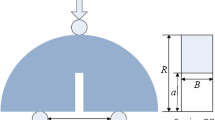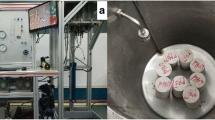Abstract
In order to study the deterioration of strength parameters of sandstone under the action of dry–wet cycles in acid and alkaline environment, laboratory tests were conducted on the sandstone specimens for 1, 3, 6 and 10 dry–wet cycles in the solutions with a pH value of 4, 7 and 9, respectively. With the strength data recorded after each cycle, the Mohr–Coulomb strength criterion parameters and the Hoek–Brown strength criterion parameters were obtained. First, the rock deterioration was briefly analyzed. Then, the failure envelopes and the failure surface on the \(\pi \) plane at different pH values after different cycles were graphed. The results show that the parameters decrease with the increase in dry–wet cycles. The deterioration is most serious when the number of cycles is small, and then becomes moderate. In addition, the deterioration coefficient of the sandstone is the largest in acidic environment (\(\hbox {pH}=4\)), followed by that in alkaline environment (\(\hbox {pH}=9\)) and that in neutral environment (\(\hbox {pH}=7\)). The deterioration effects of drying and wetting on the following parameters are as follows: fitting compressive strength > cohesion > material constant > internal friction angle. When the pH value of the soaking solution changes from 7 to 4, the deterioration coefficients of the fitting compressive strength and cohesion rise by 30%, while those of the material constant and internal friction angle rise by 10%.
Similar content being viewed by others
References
Wong, L.N.Y.; Maruvanchery, V.; Liu, G.: Water effects on rock strength and stiffness degradation. Acta Geotech. 11(4), 1–25 (2015)
Nara, Y.; Morimoto, K.; Yoneda, T.; Kaneko, K.; et al.: Effect of humidity on fracture toughness in sandstone. J. MMIJ 126(1/2), 10–17 (2010)
Naghadehi, M.Z.; Torabi, S.R.; Khalokakaie, R.: The influence of moisture on sandstone properties in Iran. Geotech. Eng. 163(2), 91–99 (2010)
Verstrynge, E.; Adriaens, R.; Elsen, J.; Balen, K.V.: Multi-scale analysis on the influence of moisture on the mechanical behavior of ferruginous sandstone. Constr. Build. Mater. 54(54), 78–90 (2014)
Verstrynge, E.; Pyka, G.; Wevers, M.; et al.: The influence of moisture on the mechanical behaviour of sandstone assessed by means of micro-computed tomography. J. Mater. Eng. 53(10), 15–19 (2009)
Hua, W.; Dong, S.; Li, Y.; et al.: Effect of cyclic wetting and drying on the pure mode II fracture toughness of sandstone. Eng. Fract. Mech. 153, 143–150 (2016)
Hua, W.; Dong, S.; Li, Y.; et al.: The influence of cyclic wetting and drying on the fracture toughness of sandstone. Int. J. Rock Mech. Min. Sci. 78, 331–335 (2015)
Vergara, M.R.; Triantafyllidis, T.: Swelling behavior of volcanic rocks under cyclic wetting and drying. Int. J. Rock Mech. Min. Sci. 80, 231–240 (2015)
Wang, L.L.; Bornert, M.; Héripréa, E.; Yang, D.S.; Chanchole, S.: Irreversible deformation and damage in argillaceous rocks induced by wetting/drying. J. Appl. Geophys. 107, 108–118 (2014)
Zhang, B.Y.; Zhang, J.H.; Sun, G.L.: Deformation and shear strength of rockfill materials composed of soft siltstones subjected to stress, cyclical drying/wetting and temperature variations. Eng. Geol. 190, 87–97 (2015)
Heggheim, T.; Madland, M.V.; Risnes, R.; et al.: A chemical induced enhanced weakening of chalk by seawater. J. Pet. Sci. Eng. 46, 171–184 (2005)
Ciantia, M.O.; Castellanza, R.; Crosta, G.B.: Effects of mineral suspension and dissolution on strength and compressibility of soft carbonate rocks. Eng. Geol. 184, 1–18 (2015)
Ciantia, M.O.; Castellanza, R.; Prisco, C.: Experimental study on the water-induced weakening of calcarenites. Rock Mech. Rock Eng. 48, 441–461 (2015)
Li, N.; Zhu, Y.; Su, B.; Gunter, S.: A chemical damage model of sandstone in acid solution. Int. J. Rock Mech. Min. Sci. 40(2), 243–249 (2003)
Fuller, I.C.; Riedler, R.A.; Bell, R.; et al.: Landslide-driven erosion and slope-channel coupling in steep forested terrain, Ruahine Ranges, New Zealand, 1946–2011. Catena 142, 252–268 (2016)
Jiang, L.-C.; Chen, J.-S.; Wu, A.-X.: Erosion characteristic of slope sandstone soaking in acid mine drainage. J. Cent. South Univ. Technol. 14(2), 236–242 (2007)
Waragai, T.: The effect of rock strength on weathering rates of sandstone used for Angkor temples in Cambodia. Eng. Geol. 207, 24–35 (2016)
Siedel, H.; Pfefferkorn, S.; Plehwe-Leisen, E.; et al.: Sandstone weathering in tropical climate: results of low-destructive investigations at the temple of Angkor Wat, Cambodia. Eng. Geol. 115(3), 182–192 (2010)
Drucker, D.; Prager, W.: Soil mechanics and plastic analysis or limit design. Q. Appl. Math. 10(2), 157–165 (1952)
Mogi, K.: Effect of the intermediate principal stress on rock failure. J. Geophys. Res. 72(20), 5 117–5 131 (1967)
Wiebols, G.; Cook, N.: An energy criterion for the strength of rock in Polyaxial compression. Int. J. Rock Mech. Min. Sci. Geomech. Abstr. 5(6), 529–549 (1968)
Lade, P.C.: Elasto-plastic stress-strain theory for cohesionless soil with curved yield surfaces. Int. J. Solids Struct. 13(11), 1 019–1 035 (1977)
Hoek, E.; Brown, E.: Empirical strength criterion for rock masses. J. Geotech. Eng. Div. ASCE 106(9), 1013–1035 (1980)
Hoek, E.: Strength of rock and rock masses. ISRM News 2(2), 4–16 (1994)
Matsuoka, H.; Nakai, T.: Relationship among Tresca, Mises, Mohr–Coulomb and Matsuoka–Nakai failure criteria. Soils Found. 25(4), 123–128 (1985)
Sheorey, P.R.: Empirical Rock Failure Criteria. A.A. Balkema, Rotterdam (1997)
Benz, T.; Schwab, R.; Kauther, R.A.; et al.: A Hoek–Brown criterion with intrinsic material strength factorization. Int. J. Rock Mech. Min. Sci. 45(2), 210–222 (2008)
You, M.: True triaxial strength criteria for rock. Int. J. Rock Mech. Min. Sci. 46(1), 115–127 (2009)
Lee, Y.-K.; Pietruszczak, S.; Choi, B.-H.: Failure criteria for rocks based on smooth approximations to Mohr–Coulomb and Hoek–Brown failure functions. Int. J. Rock Mech. Min. Sci. 56, 146–160 (2012)
Zhang, L.: A generalized three-dimensional Hoek-Brown strength criterion. Rock Mech. Rock Eng. 41, 893–915 (2008)
Singh, M.; Singh, B.: Modified Mohr–Coulomb criterion for non-linear triaxial and polyaxial strength of jointed rocks. Int. J. Rock Mech. Min. Sci. 51, 43–52 (2012)
Zhou, X.P.; Li, J.L.: Hoek–Brown criterion applied to circular tunnel using elastoplasticity and in situ axial stress. Theor. Appl. Fract. Mech. 56, 95–103 (2011)
Singh, M.; Raj, A.; Singh, B.: Modified Mohr–Coulomb criterion for non-linear triaxial and polyaxial strength of intact rocks. Int. J. Rock Mech. Min. Sci. 48, 546–55 (2011)
Sofianos, A.I.: Tunnelling Mohr–Coulomb strength parameters for rock masses satisfying the generalized Hoek–Brown criterion International. J. Rock Mech. Min. Sci. 40, 435–440 (2003)
Jiang, X.; Cui, P.; Liu, C.: A chart-based seismic stability analysis method for rock slopes using Hoek–Brown failure criterion. Eng. Geol. 209, 196–208 (2016)
ISRM: The Complete ISRM Suggested Methods for Rock Characterization, Testing and Monitoring: 1974-2006. In: Ulusay, R., Hudson, J.A. (eds.) Suggested methods prepared by the commission on testing methods, International Society for Rock Mechanics, compilation arranged by the ISRM. Turkish National Group, Ankara, Turkey (2007)
Author information
Authors and Affiliations
Corresponding author
Rights and permissions
About this article
Cite this article
Yuan, W., Liu, X. & Fu, Y. Study on Deterioration of Strength Parameters of Sandstone Under the Action of Dry–Wet Cycles in Acid and Alkaline Environment. Arab J Sci Eng 43, 335–348 (2018). https://doi.org/10.1007/s13369-017-2870-y
Received:
Accepted:
Published:
Issue Date:
DOI: https://doi.org/10.1007/s13369-017-2870-y




